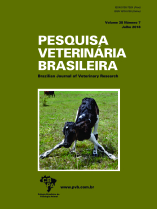 |
|
|
|
Year 2018 - Volume 38, Number 7
|

|
Prevalence and antimicrobial susceptibility of Salmonella spp. serotypes in broiler chickens and carcasses in the State of Rio de Janeiro, Brazil, 38(7):1278-1285
|
ABSTRACT.- Baptista D.Q., Santos A.F.M, Aquino M.H.C., Abreu D.L.C., Rodrigues D.P., Nascimento E.R. & Pereira V.L.A. 2018. [Prevalence and antimicrobial susceptibility of Salmonella spp. serotypes in broiler chickens and carcasses in the State of Rio de Janeiro, Brazil] Prevalência e susceptiblidade antimicrobiana de sorotipos de Salmonella spp. isolados de frangos vivos e carcaças no estado do Rio de Janeiro. Pesquisa Veterinária Brasileira 38(7):1278-1285. Departamento de Saúde Coletiva Veterinária e Saúde Pública, Universidade Federal Fluminense, Rua Vital Brazil Filho 64, Niterói, RJ 24230-340, Brazil. E-mail: daniqb@yahoo.com
The presence of Salmonella spp. in poultry products and their by-products is a major challenge for commercial production. Data about the prevalence, the circulating serotypes and the antimicrobial susceptibility profile of Salmonella spp. strains in the State of Rio de Janeiro are scarce. Therefore, the aim of this study was to detect the presence of Salmonella spp. in live chickens and carcasses in slaughterhouses of the State of Rio de Janeiro, to identify the serotypes and to evaluate the antimicrobial susceptibility of these strains for fluoroquinolones and beta-lactams. Sixty cloacal swabs samples from broiler chickens and sixty samples of carcasses from six slaughterhouses under State Inspection were collected. The isolates were serotyped and resistance was tested to eight antimicrobials: enrofloxacin, ciprofloxacin, norfloxacin, cephalothin, ceftiofur, cefotaxime, amoxicillin/clavulanic acid and ampicillin by disc diffusion method. The results showed a prevalence of Salmonella spp. of 1.66% (1/60) in cloacal swabs samples and 26.66% (16/60) in carcasses. In cloacal swabs sample only Senftenberg (1.66%) serotype was isolated. In total, seven different serotypes were obtained from carcasses: Senftenberg (15%), followed by Mbandaka (8.3%), Schwarzengrund (3.3%), Cerro (3.3%), Ohio (3.3%), Minnesota (1.66%) and Tennessee (1.66%). Regarding antimicrobial susceptibility, 29 (87.87%) isolates were sensitive to all antimicrobials tested and 4 (12.12%) isolates were resistant to three or more beta-lactams antimicrobials. No susceptibility to fluoroquinolones was observed. These results showed a prevalence of Salmonella spp. higher than expected in slaughterhouses in the State of Rio de Janeiro, besides the presence of several serotypes of Salmonella spp. The resistance found for beta-lactams alerts to the spread of these strains through the food chain. |
| |
|
|
| |
|
 |